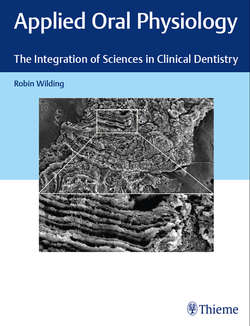Читать книгу Applied Oral Physiology - Robin Wilding - Страница 71
На сайте Литреса книга снята с продажи.
4.3.1 Biofilms
ОглавлениеSlime is an everyday description of the slippery film, which covers surfaces which are always wet. Slime collects on the inside of water pipes, the bottoms of ships, artificial heart valves, the lining of the gut, rocks, and plants in ponds, rivers, and sea. The word slime tells us that is slippery but not that is made up of living organisms, so biofilm is a more accurate description. Biofilms have a most interesting characteristic, in that the different species of bacteria show levels of interaction, cooperation, and organization not found in their free-swimming or planktonic forms. The collective behavior of organisms creates a microecosystem. Over time, a stable hierarchy and balance between the different species develop. As we have noted in other ecosystems, some organisms, the keystone species, have a disproportionate influence. These organisms may influence the structure of the biofilm, and if it is in a symbiotic relationship with a host, the keystone species determine the biofilms’ relationship with the host.
The deeper layers of a biofilm have a lower concentration of oxygen than the surface layer. These oxygen-depleted layers provide a suitable microenvironment for anaerobic organisms which are unable to survive in the oxygen-rich (aerobic) environment of the oral cavity. The deeper layers of the biofilm would also have lower concentrations of nutrients were it not for channels which are maintained for the transport of nutrients through the mass of organisms.
Fig. 4.7 A SEM image (magnification × 300) of calcified plaque (calculus) which was etched to remove all the organic material. The remaining calcified material reflects the structural organization of the living biofilm just as a piece of dried coral is a relic of the ecosystem of the living reef. The insert (magnification × 1000) reveals laminations and channels which the organisms have constructed to define a variety of habitats within the plaque biofilm.
These channels may be seen in an oral biofilm which has calcified (calculus), a process which mineralizes the soft matrix and preserves its architecture (▶ Fig. 4.7). The gradients of substrate concentration, oxygen availability, and pH in the complex structure of the biofilm provide a wide variety of habitats for microorganisms. The structural organization and functional coordination of organisms in a biofilm and the specialized role of some species, which orchestrate the behavior of other species bring biofilms close to the realms of a single organism.
The external environment has at first a decisive influence on the early colonizing species of a biofilm. As the biofilm matures, the cooperative influence of the early colonizers creates an inner structural and functional organization. The biofilm begins to create its own inner environment which supports organisms that would not otherwise survive in the external environment. This dynamic, in which organisms create a purpose-defined environment for the benefit of their own and other species, requires a review of accepted evolutionary theory. This orthodox view places the organism within an environment to which it must adapt or die. The restriction has not provided for the organism to create its own environment by cooperation with other species. Cross-talk between organisms, now known as quorum sensing, would have been ridiculed just 50 years ago. It is about 50 years ago an idea, suggested by James Lovelock, that the biosphere regulated itself was also ridiculed. The theory was unfortunately given a mystic name Gaia (earth mother), but it was supported by serious scientists. The more that is understood of the structural and organizational microenvironments created by biofilms, the more likely it becomes that the Gaia theory of biosphere self-regulation is a manifestation of an upscaled version of the self-organization found in biofilms (see Appendix D.3 Gaia Theory).
